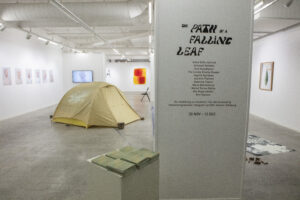
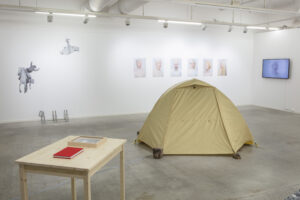
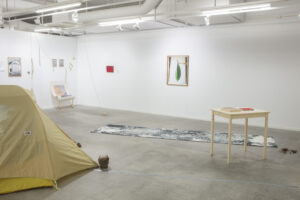
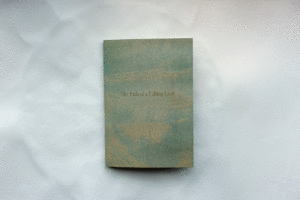
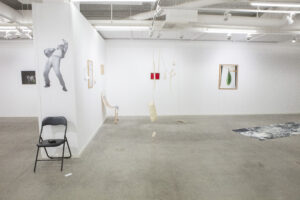
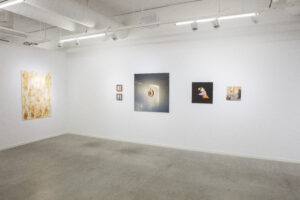
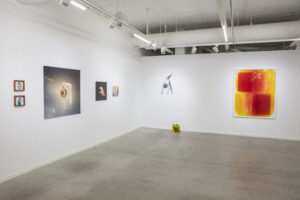
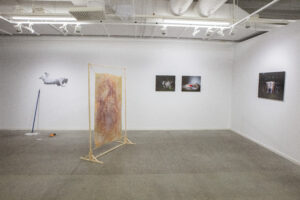
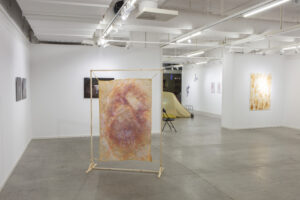
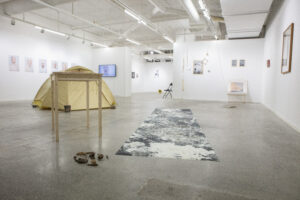
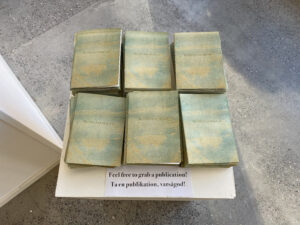
Regarding Photography When Facing a New Normal.











Many galleries and museums are still closed with no official date for opening again and some aren’t opening at all. And for the exhibitions, they are being closed and postponed. In some cases, the exhibitions have moved online with digital walk-throughs or virtual tours. Schools are also being held closed, even though some manage to continue with restrictions and limited access for the students. It’s safe to say that almost everything has gone online, and we’re living in a time where isolation and keeping distance is necessary. This has become our new way of living.
As I am writing this text, one year has gone by and we’re still in the pandemic of COVID-19, possibly approaching the “third wave”. I am studying my final year at the master’s program in photography at HDK-Valand – Academy of Art and Design, in Gothenburg, Sweden. Suddenly, I found myself reflecting upon what has happened, and what is happening. Me and my class are about to complete an artistic master’s degree, that’s mainly been based on Zoom, and it has not worked as well as we had hoped.
Back when it all started, as a student, there was a lot of uncertainty whether we could see each other in class again or be able to work and use the many workshops and facilities the academy had to offer, and if we would be able to do the exhibitions that were a part of the education. We still don’t know what the future holds, or if we will ever be able to go back to what, back then, seemed normal.
Questions are raised within the art scene and the art academy. Questions like: Will we survive the pandemic? Do we need the art academy? What purpose does art have in our society?
Regarding the circumstances, I wanted to shed some light upon my own class, the class of 2019–2021, that somehow managed to arrange an exhibition in the autumn of 2020. With this text, I wish to turn this exhibition into a written memory.
Galleri Format is one of the few galleries in Sweden that specialize in showing photographic art. It’s situated in Malmö, a city on the southern coastline of Sweden.
In 2015, Anna Strand, practicing artist and teacher at HDK-Valand, started a conversation with Galleri Format, to see if there was any possibility for the students to exhibited. This discussion has further led into an agreement with the gallery and the academy. Now, each autumn, the second-year master students in photography at HDK-Valand will exhibit together in a group show at Galleri Format.The first exhibition with the students was held in 2015, by artist and back then professor at HDK-Valand, Lotta Antonsson.The Path of a Falling Leaf became the first exhibition where Anna Strand was involved in the process as a teacher.
Experiencing The Path of a Fallen Leaf
Just to paint a picture, I would now like to guide you through the gallery space at Galleri Format. To give you an impression of how the exhibition was displayed. Surely, we’ll move into details later.
We step into the gallery space. To the left you’ll find a large bottle of hand sanitizer. Right ahead, you’ll see the exhibition The Path of a Fallen Leaf, shown by the master students in photography at HDK-Valand. All in all, eleven students are participating.
The gallery is divided into two exhibition spaces. The first space, the one you’ve just entered, is an open space with loads of light pouring in through the windows.
On your right hand, you’ll find the exhibition’s publication and a folded paper booklet with more detailed information about the exhibition.
Within the first exhibition space, you’ll find works by the artists Fia Linnéa Emelie Doepel, Joachim Fleinert, Mia Rogersdotter Gran, Anna Sofia Jernryd, Mercè Torres Ràfols and Armand Tamboly.
Here you find that photography is being presented by different techniques such as camera-less photography, installation, performative text, photographic stickers, portraits, videos, constructions, objects and handwritten notes.
In the second exhibition space you’ll find work by the artists Marie Barthelsson, Ingvild Davidsen, Joachim Fleinert, Erik Gustafsson, Nini Hansen and Katerini Tsakiri.
Here photography is being presented as a result of an experiment, staged photography and self-portrait, but also sculpted with fabric and screen printed with fire.
In connection with the exhibition a publication was made. The publication was printed in riso by Jeminipress in Stockholm, and edited by the master students Ingvild Davidsen, Marie Barthelsson and Katerini Tsakiri.
Inside the publication, you can find riso-printed works by all the artists of the exhibition, and three texts written by the artists and professors Anna Strand, Annika Elisabeth von Hausswolff and Liz Wells.
Since all the works inside the publication were printed in riso, it created a collective balance between the artists and their works. This added a new layer to the works themselves and to the exhibition. Giving us an impression of the class coming together, creating something new by trying a different but common approach.
In the publication, Anna Strand, artist and teacher, writes about her student’s works:
Each of these artists work individually, but also engage in each other’s processes with great dedication. Their paths overlap, run parallel, pass by, touch, deviate from each other and then meet again in the works that will make up the exhibition.
Here, the photograph is made visible as an object in a variety of ways. In several cases, the object or objects are the result of experiments in which photographic and related materials – and in some cases intuition – have led the work. Two of the artists describe their practices in a similar way, characterised by the oscillation between destruction and construction, darkness and light, death and life. It is meant metaphorically and, at times, in a concrete manner. Another artist develops sugar-based images with the aid of fire, a lingering scent is added to what we see.
There are images that have become parts of installations. A projected image also appears as a physical object, onto which dreams and desires can be directed. In this case the objective is to reflect over an inaccessible place. Several of the artworks approach other places with wonder and, at the same time, great care. Perhaps as a way to emphasise the difficulties in understanding, depicting and describing a place objectively or, for example, from the perspective of destroyed trees. Another work continues along similar lines by suggesting that the understanding of invasive and other plants can shift if we let go of the human perspective.
A found photograph has been combined with contemporary images, as if to say – look how time has passed and yet stood still. Other artists use staged photography to reference images in art history and popular culture as a way to examine identity and our understanding of how we are shaped as people, gender and artists. Staged photography is also employed from another perspective: dealing with the loss of one’s notion of self in relation to the person who should have been closest. Here, and in other works, text accompanies image. Not to explain, but to create an immersive experience where multiple voices exist, giving rise to a space in-between image and text for the viewer to discover.
The title of the exhibition is in itself a text to spend time with. A falling leaf must, in the end, land – while I wish for the exhibiting artists to maintain in the ongoing. I would like to think of the exhibition that you now see as a stop-off point.
Strand’s text gives us a good description of the student’s works while she also gives us an idea of how photography here is represented within a larger context, connected to how we see, think and reflect upon photography in itself. Since photography is such a flexible discipline, it has opened up for development and by time expanded into new ways of thinking and seeing, and also put into new media. This is still an ongoing process. We are continuing to explore photography and introducing it to new forms and formats. Continually, expanding the idea of the photograph.
On that note, I would like us to step back to the contents of the exhibition The Path of a Fallen Leaf. Because, within this exhibition we are introduced to the photographic medium in many different ways. Here, photography is contextualised and taken into new ideas, giving us a better understanding of the many layers that are in the practise of photography.
Mia Rogersdotter Gran writes about her work Summit of Dreams;
Video (13min), yellow tent, sleeping bags. 2020.
On average one spends 10–15 minutes at the top of the world’s highest mountain. The longer you stay at this altitude, the higher the risk is for you to die. This obsession with the mountain can take you anywhere, but for me the obsession has never taken me anywhere. So, I made this installation, as a love letter to the unreachable mountain.
Summit of Dreams is an installation piece. We see a tent with a projection where a preformed act is being displayed onto the tent’s canvas. The projection shows us a picture of a mountain peak from afar. Slowly, we can see a hand moving in and petting the mountain’s peak. The piece is quiet and gently reflects an impassioned desire of the artist’s dream and obsession. And it implies the intimacy there is within the act of dreaming, while at the same time embracing it.
Further, Armand Tamboly is represented with six portraits and one video, screening in a loop. The portraits are pale and mounted on acrylic glass. We can see that the people that are portrayed in the pictures on the wall, appear in the video as well, sharing with us, how they experience daily life. Tamboly’s project are titled I Will Always Be a Stranger. He writes:
60×40 cm. Photography, print on acrylic glass. Video (10min). 2020.
Titles from left: Stjepan, Boris, Xueli, Clement, Svetlana, Bolu
This project is about people with albinism and the aim for the project is to raise awareness and let people with albinism tell us more about their life in different societies. People with albinism face difficulties in many countries around the world, these vary from being bullied or harassed, being expelled from families and losing their body parts or life in other places.
Fia Linnéa Emelie Doepel shows us her project The Forests in Themselves Have for a Long Time Been Spoken of as a Multitude of Living Creatures. Doepel writes about her work:
1000x 4000mm, enlarged photogram, Giclée fine art print, installation, original polaroid, ash frame, museum glass, hand bound artist book, scent made from organic matter found on the clear-cut.
2016–2020.
Subtitle: 10:1, dirt, moist, fir needles, 23 days and nights, rain, wood, presence and absence of light. Hiisi
The work ‘The Forests in Themselves Have for a Long Time Been Spoken of as a Multitude of Living Creatures’ is a collaboration between a clear-cut forest located on the southern coast of Finland and myself. In this work I want to investigate what happens to the communication – between individuals, the creatures and the trees that make up this particular ecosystem – when the trees are cut down. The process is based on interaction and through engaging with the ground and its critters, the notion of animism is evoked.
In this work we are introduced to camera-less photography as a working method when collaborating with a clear-cut forest. Doepel also includes scent and text, inviting us to get a better understanding of the process and its geographical site. It also opens up for us to reflect on the forest as a living creature, and the damages that entail in the act of clear-cutting.
In Anna Sofia Jernryd’s work Nature is Out of Control, we can see a hand wearing a plastic glove while holding a big green leaf. The leaf is much bigger than the hand and by its form, size and vibrant green colour, one gets the impression that this leaf is of a tropical plant. The plastic glove indicates that this may be something toxic, but in which context? Jernryd writes about her work:
88,5x70cm. Photography, inkjet print. 2020.
Nature is Out of Control relates to human beings’ ignorant relation to nature. Accidentally or intentionally, we relocate animals, plants and other organisms from their natural habitat. In their new environment some, like the Yellow skunk cabbage, become invasive, negatively impacting native biodiversity, ecosystems and, in the end, our own well-being.
Mercè Torres Ràfols work Two Ships Once Met Somewhere in the North Sea One Saved the Other and Together Went Back Home Said Goodbye and Never Met Again is an installation that contains soft fisherman’s tools hanging by a thread, handwritten notes and pictures framed and mounted in different ways with rocks. One feels as this is some kind of treasure hunt, mind mapping impressions, taking in and exploring a foreign place. Torres Ràfolswrites:
Installation. Photography, pillow-sculpture, found materials, text. 2019-2020.
Hi Marianne, I have to force myself to fall in love with this place, I’ll stay for 2 more years. On islands you can’t so easily escape, you know? You get really blinded when the sun reflects on the white houses, how am I supposed to get to see the glacier rocks, then? It feels I am the one in land waiting for something to return. Are you visiting me soon? No-one understands when I speak, I’ve been trying to imitate them, but it doesn’t work either. Oh, news from last summer! I caught a total of 43 mackerels: What do you think, am I already a fisherman or am I a serial killer?
Four of the works within this exhibition are presented by Joachim Fleinert. You’ll find the works Everyday Objects and Falling Cowboys to be spread out in different places when going through this exhibition. In these works, Fleinert is working with his own experiences, criticising how society treats the artist in a working context. Fleinert writes:
5 images attached to the wall in various sizes, 4 installations in various sizes. 2020.
Self-portrait I, Self-portrait II, Self-portrait III, Self-portrait IIII, Self-portrait IIIII
Can you pay with two bottles of wine in Netto – I can not. (Shopping bad, wine)
Economically dependent on my partner. (Chair, wallet with content)
I would buy a train ticket if I could afford it. (Bike cycle stand, lock)
I know how it feels to take an unqualified day job. (Floor mop, working glove)
Inspired by extracts from articles and surveys studying the living conditions of artists in Denmark over the past few years, the self-portraits in Falling Cowboys and the scenarios in Everyday Objects are closely related to my own personal story. Illustrated with the cut-outs from classic western movies the life of visual artists is occasionally compared with the Wild West as a parallel to the norm in society. Especially during a crisis.
Nini Hansen’s work Rapture is a large print mounted out from the wall, giving us an impression of it floating, playing with the concept of rapture, something holy and divine. Hansen’s material description “aphrodisiac, sugar and fire on satin paper. Developer: Heat. Silk screen print, 95x140cm. 2020.” indicates that the print includes many different layers. From the looks of it, it seems like the image is burnt into the paper, while the work itself carries a sweet scent. By the scent, one gets intrigued, which we further can relate to the aphrodisiac. There’s a spotlight placed on the print, making us aware of the tiny crane fly that is in the image, bringing it forth.
Katerini Tsakiri’s work Praise to the Holy Mountain is presented with five pictures, all in different sizes: two tiny ones, framed with wood, one large and the last two a bit smaller than the largest one, mounted on the wall in a horizontal line. In this work, Tsakiri’s research on how we have portrayed the female breast within history and culture, is being visualised. Tsakiri plays with representation, scale and stereotypes, and writes:
Photography, inkjet print. 2020.
You rise above us, the dawn light strikes your beautiful summit.
The golden river flows from your peak to our bodies.
I offered you the sacrifice of a melon in exchange for protection.
Erik Gustafsson’s work Untitled VI (Folding Series) is one large image framed with a thin white frame, balancing the work, setting the vibrant colours within the image in focus. From afar the image gives us a calm impression of unity. When inspecting the work closely, one can see that the picture in itself contains of two larger c-prints mounted together into one image. Gustafsson writes about his practise:
154x121cm. Unique c-prints, mounted on dibond, white wooden frame, museum/UV-glass. 2020.
Through his painterly-like methods and experiments, Gustafsson explores where the limits of photography begin and end, and thereby tries to expand, renew and rethink the modes of photographic expression.
Gustafsson’s work is a playful piece. Here, the experiments that lay within the practise of photography are being embraced and made visible to us when examining the work.
The work Portrait by Ingvild Davidsen, is an independent work within the exhibition space, as it stands by itself. Davidsen’s material description indicates that this is a photographic textile sculpture. As one walks and moves around it, we can see the work gently wave back and forth in its frame. We can also see that the work has two different sides where one is more transparent than the other. One side seems to have another layer, coated in wax, disturbing its surface. Davidsen writes:
180x130cm. Photography, textile, sculpture. 2020.
A portrait can be a representation or an impression of someone or something.
The last work presented in this exhibition is Suddenly, Through an Opening, the Spring Light Fell into the Room by Marie Barthelsson. The work consists of two smaller pictures and one large, mounted on dibond. The pictures are dark and intimate. Barthelsson writes about her work:
40x60cm, 60x90cm. Pigment print on paper, mounted on dibond. 2020.
The series portrays my own experience of a period of perceived seclusion. The genesis for this series has been my own experience. In creating these images, it has been important to endeavour to convey what I have felt within me, in the space of the metaphorical and physical waiting room. These are my diary entries in the form of pictures.
But what is the purpose of turning this exhibition into a written memory? In the publication, artist and teacher, Annika Elisabeth von Hausswolff writes:
As a child I used to play in the backyard, where two giant elm trees stretched towards the sky.
In one of them my father had attached a long rope with a big knot for me to use as a swing.
One day I decided to do an experiment; I pulled the rope in the old tree the same way you make a church-bell chime. I was curious to see whether I, by making the branches of the tree move, could provoke the wind to sweep through the backyard. And indeed, I felt a light breeze touch my chin.
To be clear; it was the branches moving that started the wind, not the other way around.
The next day I tried to re-create the wind and lo and behold,
I managed to blow up a storm. This made me realize I could control cause and effect.
I was an inventor, a creator and a mastermind. Some of that magical thinking is necessary when creating art. You have to be a believer in order to transgress the boundaries of logic into the poetic realm. Please maintain a healthy relationship to your inner child who once was a
Queen and ruled the world.
Hausswolff points out the importance of creating art in a larger context, and why we need to continue practising the arts. From experience, we already know the impact art has on our culture and the structures within our society. How it can raise questions and change our ways of seeing, thinking and acting. While it’s important to be critical, it’s also important to show nuance, something art can help with opening up to. To keep on being playful and creative, in order to move forward.
One Wednesday in March, year 2021, I listened to a debate where the future was discussed. The debate was held by Malmö Konstmuseum. While the panel was discussing, images of artistic works were shown in relation to the debate question: How do we imagine the future? What was interesting, was that in the end the panel ended up with a mutual understanding and concluded that we need the artists to keep on creating, to find new solutions for how to save our future.
In The Path of a Falling Leaf one is introduced to photography on many levels. Here photography is combined with different art practises. While moving through the exhibition, one can experience and see all the artists’ curiosity, drive and interests in investigating and researching each topic. One definitely gets a better understanding of why photography keeps on developing further.
To set this in perspective, in 2015, Gallery MELK in Oslo, Norway, published a book called New Scandinavian Photography. When looking through their book, I remember thinking that it was all the same, and I did not believe or agree with them, because neither of my colleagues could fit into this category. As MELK themselves have stated on their website, they choose all the artists themselves, without any interests from applications or open calls. In other words, an artist cannot contact them, they contact the artist. With this in mind, one can understand why their selection is limited and does not show much variation.
Maybe one doesn’t see this as a problem, but in general, when we start defining something, without bringing in the whole perspective of variety and range, we automatically end up with excluding all others. I’m mentioning this as an example to point out something that is crucial for photography, when looking at photography as a discipline.
When thinking about what photography is in itself – “just a picture on a piece of paper” – I would rather like us to think of photography as a result of an experiment, that keeps on developing further into new experiments. Allowing the photographic medium to expand and develop with time, is probably the reason why photography still exists. And when thinking of the drive and curiosity one has as an artist, I’m not surprised that photography still is accurate and very central within the arts.
In the publication, Liz Wells, Emeritus Professor at Plymouth University, honorary doctorate at HDK-Valand, and during the pandemic, supervisor for the master students in photography, writes:
Fall
The wind rustles through the leaves loosening them one by one
to gently fall from their branches to the ground…
…where they settle into the mulch that will enhance the soil
beneath my feet as I take my daily walk along the beach
and up the village lanes in the autumnal afternoon sun
that retains little of the warmth it conveyed only a few weeks ago…
…during the pandemic that has devastated many families
whilst confining others to the surroundings of our homes
now more familiar to us than ever before.
Trees, once arched into summer avenues,
now dissolve into stark winter sculptures,
green leaves transitioning russet red…yellow…brown…
…as they fold into the folds of the earth that holds us.
Liz Wells
October 2020
Even though this exhibition was held during the pandemic, Galleri Format stated that The Path of a Fallen Leafwas one of their most visited exhibitions ever.
Out of the eleven artists, two sold their work. HDK-Valand has later mentioned that this was also a first, since their students have not sold their works before, when exhibiting at Galleri Format.
For the students this was a big achievement, to have experienced and together made possible, even though the circumstances made it hard.
Do the restrictions make visitors more eager to look at art in the exhibition space? Have the shutdowns made us more appreciative of the time we spend in galleries or museums when looking at art? Since there now is more space for the works as well as for the visitors. Time to observe and think, without other distractions. Maybe this has been beneficial for the artists? Isn’t it more inviting, now that there’s place to take time? And since the time often is scheduled, maybe visitors feel more obliged to plan one’s visit, and will therefore spend more time looking at the exhibition. You don’t know what you will miss, before you miss it, you know.
It’s been a rough year, and as we now know, we have entered a new time and era. This new way of living will possibly continue for a while. Some hope for it to disappear within a year’s reach, others think it will last a lifetime. No one knows how long this will continue, but one thing is for sure. Regarding photography when facing a new normal, it seems as if we are still inspired to continue developing. Continue to expand the horizon. Continue to exhaust its discipline, reflecting and criticising its format. Trying new ways of representation and new approaches, both offline and online, in real life and virtual life.
Lastly, to put all of this into perspective, when I was eight years old, I went to school to participate in my first photography class. I had gotten the teacher’s approval to borrow my dad’s 35mm automatic Fujifilm camera and I had no idea if my photographs were any good or if they would appear at all, when the film was developed. And I would never have guessed or imagined that photography would be digital, and that the limit of how many pictures one could take, would be counted in gigabytes and then saved onto a memory card, and that it all would be stored on a hard drive or a phone.
So, I cannot help but wonder what photography will be like in the future, how it will appear, and within what frames it will work. Since, when drawing conclusions from what has been seen before, the possibilities are endless.
Where do we go from here?
Documentation:
All photo documentation was taken by Ingvild Davidsen, Fia Linnéa Emelie Doepel Erik Gustafsson, Armand Tamboly and Katerina Tsakiri.
Footnotes:
Liz Wells, The Path of a Falling Leaf, 2020, Stockholm, Jeminipress, p.1.
Anna Strand, The Path of a Falling Leaf, 2020, Stockholm, Jeminipress, p.8-9.
Annika Elisabeth von Hausswolff, The Path of a Falling Leaf, 2020, Stockholm, Jeminipress, p.23.
Ingvild Davidsen, The Path of a Falling Leaf – Exhibition booklet, 2020, Malmö, Galleri Format, p.2.
Joachim Fleinert, The Path of a Falling Leaf – Exhibition booklet, 2020, Malmö, Galleri Format, p.2.
Erik Gustafsson, The Path of a Falling Leaf – Exhibition booklet, 2020, Malmö, Galleri Format, p.2.
Nini Hansen, The Path of a Falling Leaf – Exhibition booklet, 2020, Malmö, Galleri Format, p.2.
Armand Tamboly, The Path of a Falling Leaf – Exhibition booklet, 2020, Malmö, Galleri Format, p.2.
Katerina Tsakiri. The Path of a Falling Leaf – Exhibition booklet, 2020, Malmö, Galleri Format, p.2.
Marie Barthelsson, The Path of a Falling Leaf – Exhibition booklet, 2020, Malmö, Galleri Format, p.3.
Fia Linnéa Emelie Doepel, The Path of a Falling Leaf – Exhibition booklet, 2020, Malmö, Galleri Format, p.3.
Anna Sofia Jernryd, The Path of a Falling Leaf – Exhibition booklet, 2020, Malmö, Galleri Format, p.3.
Mia Rogersdotter Gran, The Path of a Falling Leaf – Exhibition booklet, 2020, Malmö, Galleri Format, p.3.
Mercè Torres Ràfols, The Path of a Falling Leaf – Exhibition booklet, 2020, Malmö, Galleri Format, p.3.
Reference and Other Articles to Read While We’re at it:
Youtube (Website), https://www.youtube.com/watch?v=qrRRhoS3KFk (Accessed 2021-04-01).
Jeminipress (Website), https://jeminipress.se/ (Accessed 2021-04-01).
Ugotphotography (Website), https://ugotphotography.se/ugot-distance-2020/ (Accessed 2021-04-01).
C-print (Website), https://www.c-print.se/post/the-spring-graduates-2020 (Accessed 2021-04-01).
Galleriformat (Website), http://galleriformat.nu/2020/kommande-path-falling-leaf/ (Accessed 2021-04-01).
Kunstkritikk (Website), https://kunstkritikk.com/the-end-of-art-education-as-we-know-it/ (Accessed 2021-04-01).
Kunstkritikk (Website), https://kunstkritikk.se/covid-19-utmaning-for-svenska-konsthogskolor/ (Accessed 2021-04-01).
Kunstkritikk (Website), https://kunstkritikk.com/an-unforgettable-year/ (Accessed 2021-04-01).
Kunstkritikk Website), https://kunstkritikk.com/crises-at-the-art-academies-in-oslo-stockholm-and-copenhagen/ (Accessed 2021-04-01).
Kunstkritikk Website), https://kunstkritikk.com/academisation-must-die-so-that-art-may-live/ (Accessed 2021-04-01).
Kunstkritikk Website), https://kunstkritikk.com/will-the-artists-of-the-future-come-from-the-banana-school/ (Accessed 2021-04-01).
Kunstkritikk Website), https://kunstkritikk.com/artistic-research-is-a-threat-to-artistic-freedom/ (Accessed 2021-04-01).
Kunstkritikk Website), https://kunstkritikk.com/representation-matters/ (Accessed 2021-04-01).
Art and Education (Website), https://www.artandeducation.net/announcements/383629/classroom-corona-kino (Accessed 2021-04-01).
Art and Education (Website), https://www.artandeducation.net/schoolwatch/379771/no-access-no-fees-an-update-on-art-education-in-the-uk Accessed 2021-04-01).
MELK Galleri (Website), https://www.melkgalleri.no/new-scandinavian-photography/ (Accessed 2021-04-01).
Facebook (Website), https://www.facebook.com/konstmuseummalmo/videos/265630315240833/ (Accessed 2021-04-01).
Malmö Stad (Website), https://malmo.se/Uppleva-och-gora/Konst-och-museer/Malmo-Konstmuseum/Malmo-Konstmuseum-hemifran/Livesant-samtal-Att-forestalla-sig-framtider-del-1..html (Accessed 2021-04-01).
I DO ART (Website), https://www.idoart.dk/blog/vis-os-dit-karantaene-atelier-7 (Accessed 2021-04-01).
I DO ART (Website), https://www.idoart.dk/blog/vis-os-dit-karantne-atelier-6 (Accessed 2021-04-01).
I DO ART (Website), https://www.idoart.dk/blog/kunstscenen-under-covid-19 (Accessed 2021-04-01).
I DO ART (Website), https://www.idoart.dk/blog/kunst-er-ikke-kun-fysiske-ting (Accessed 2021-04-01).
WIKIPEDIA (Website), https://en.wikipedia.org/wiki/Impact_of_the_COVID-19_pandemic_on_the_arts_and_cultural_heritage (Accessed 2021-04-01).